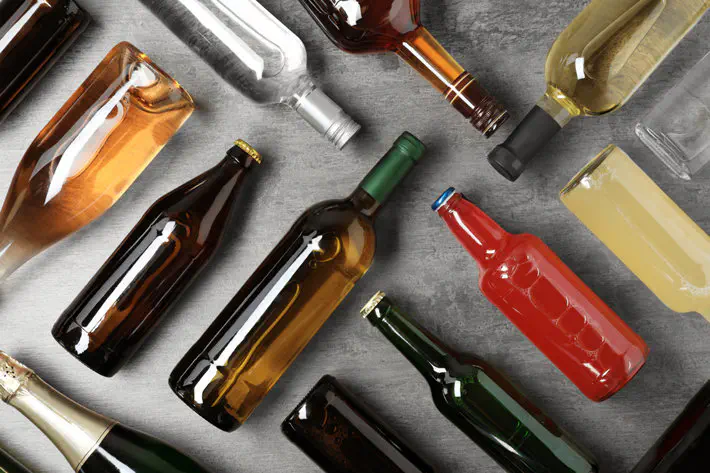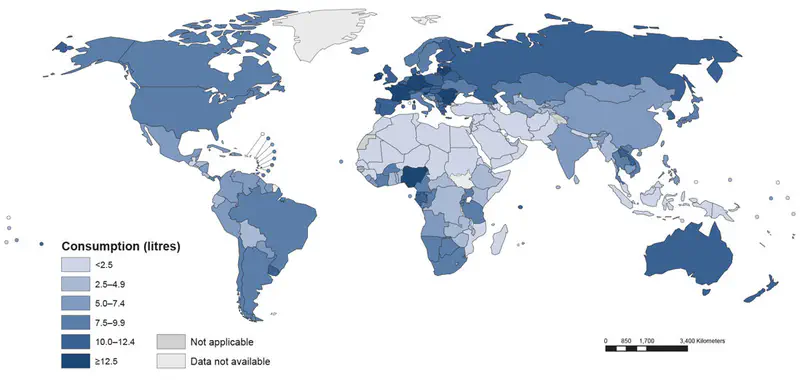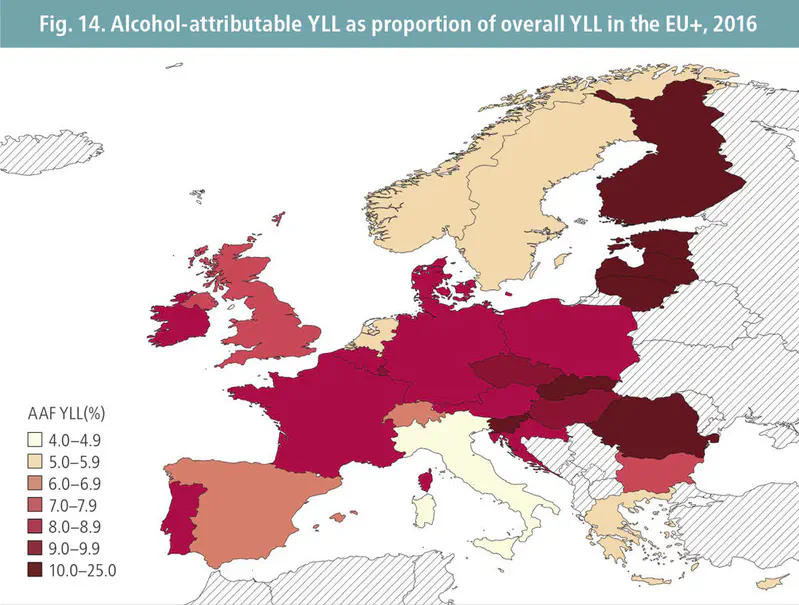DRUGS: WHAT YOU
NEED TO KNOW Booklet

Signs and Symptoms of Alcohol Abuse

In 2012, the World Health Organization’s Regional Office for Europe headquartered in Copenhagen launched a nine-year program intended to reduce alcohol consumption.1 As the program materials stated, this area has the “unenviable position of being the region of the world with the highest levels of alcohol consumption and alcohol-related harm.”
This report goes on to list the areas of life that would improve if alcohol consumption were lowered:
- Gains in population health and well-being
- Enhanced employment and productivity
- Increased health and social welfare financial savings
- Greater health and economic conditions
- Bettered social interaction and atmosphere
These are all improvements that benefit the entire population, not just excessive drinkers.
Harm from Excessive Alcohol Consumption
It’s very likely that nearly every adult could identify some of the harms caused by too much alcohol. But too many people can’t stop abusing alcohol, even though they know what these harms are.
They include:
- Damage to growing fetuses that could affect the person their whole life
- Toxicity impairing brain development and the brain health of fully-grown adults
- Intoxication that leads to increased traffic accidents and accidental injuries
- An increased incidence of seven types of cancers
- Contribution to an increased risk of communicable diseases due to lowered immunity
- Greater incidence of domestic violence involving spouses and children
- Addiction to alcohol
Added to these serious risks are the health problems significantly contributed to or worsened by high consumption of alcohol.2
- Cirrhosis of the liver which can become fatal
- Heart disease
- Tuberculosis
- Diabetes3
- Mental health problems, including dementia and suicide

Unfortunately, the greatest number of alcohol-related deaths occur in drinkers who are between the ages of 15 and 34. Approximately every fifth death among young adults between 15 and 19 years of age was caused by alcohol. Among those aged 20 to 24 years of age, the ratio was about one in four.
It would be wise for a person who makes a habit of drinking a high quantity of alcohol to consider the risk they are taking. It would also be wise to educate young people on the risks they are taking if they drink too much.
How Many of Us are Drinking Too Much?
According to a 2019 WHO Status Report on alcohol consumption across Europe, alcohol consumption was lower in northern and southern countries and highest in the middle.3 Among those who drank, the average annual consumption was nearly 22 litres of pure alcohol for men and less than 8 litres for women.
This 2019 report states that alcohol consumption has not changed since 2010, which indicates the failure of the WHO plan launched in 2012.
This map shows you the relative Alcohol Per Capita Consumption among all adults in European countries (not just the drinkers). That’s how much alcohol is drunk per person, per year, on average. But note that this is PURE alcohol (100% alcohol), not alcoholic beverages which are typically 7% to 50% alcohol.

Courtesy of the World Health Organization
Where Are the Greatest Number of Years of Life Lost?
One of the measures of damage done by alcohol is the statistic Years of Life Lost (YLL). When a person dies prematurely from either illness or accident, their age is taken into account. From these measures, a calculation determines how many years of life are lost due to alcohol consumption.
Here’s how different countries rank in this statistic:

Courtesy of the World Health Organization
Highest Number of Years of Life Lost:
- Denmark
- Finland
- Luxembourg
Medium:
- Austria
- Belgium
- France
- Germany
- Ireland
- Portugal
Low:
- Italy
- Netherlands
- Norway
- Spain
- Sweden
- Switzerland
- UK
In France, one survey found that more than one-third of men under the age of 35 drank to a risky level.4 Only about 15 per cent of French women did.
In Denmark, both men and women drink significantly more than their counterparts in other countries.5 In Finland, despite improvements, more than a half-million Finns drink to risky levels. And in Ireland, the Alcohol Per Capita Consumption equal to 41 litres of gin or vodka.6 That’s even taking into account the Irish who don’t drink, which means many people are drinking much more than this amount.
Remedying Excessive Alcohol Use
Helping people modify their drinking habits can preserve these lives and let people enjoy more years with their families, pursuing their careers or simply enjoying themselves.
By watching for signs that alcohol consumption is dangerously high, families and friends can be alerted to the fact that their loved one needs support to reduce their alcohol use. They can watch for signs like these:
- Does this person drink excessively even though they will be driving later?
- Do they go to work, school or other events drunk or hungover?
- Have they suffered illnesses or injuries related to drinking but still didn’t quit?
- Have they had blackouts after drinking?
- Do they have a physical condition they know would be worsened by drinking, but they still drink?
Have they acknowledged a problem with their drinking but have been unable to stop? These signs point to a problem that is out of control. In this case, the most caring thing friends and families can do is to locate a rehabilitation program that can help them start a healthier life.
A healthier life comes about when a person does not feel compelled to drink just because they have access to alcohol. They can also stop planning their life around their need to get their hands on alcohol. Instead, by living a healthier life, they can begin planning to enjoy events with their families or contemplating more success in their careers.
Anyone who has lost control of their drinking deserves this support. No one wants to be addicted to alcohol, no matter what they might claim when challenged by their loved ones. Everyone truly wants the chance to enjoy a productive life filled with hope. Effective rehabilitation makes that kind of life available at last.
Sources:
-
World Health Organization Regional Office for Europe (2012), “European action plan to reduce the harmful use of alcohol 2012–2020.” WHO action plan (PDF) ↩︎
-
World Health Organization (2018), “Global status report on alcohol and health 2018.” WHO report (PDF) ↩︎
-
World Health Organization (2019), “Status report on alcohol consumption, harm and policy responses in 30 European countries 2019.” WHO Report (PDF) ↩︎ ↩︎
-
The Local FR (2018), “Young French people’s ‘risky’ thirst for alcohol revealed in new study.” News Article ↩︎
-
World Health Organization Regional Office for Europe (2019), “Denmark—Alcohol Consumption, Harm and Policy Responsiveness.” WHO Report (PDF) ↩︎

 ®
®
